Over the long weekend we capped off the leaky pipes in the kitchen, nailed down the OSB flooring, and finished painting one of the upstairs bedrooms. Now all we need to be able to sleep there is a bed!
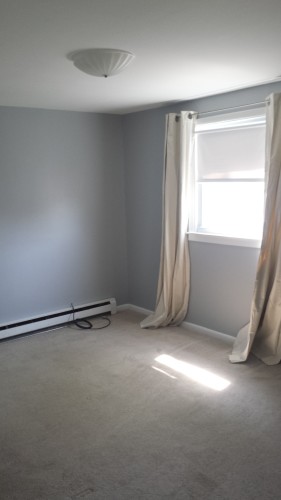
On Sunday Chris and Jen started assembling the cabinets for the kitchen while I tried to make sense of the installation instructions. It’s not easy. There are multiple sets of instructions you have to cross reference and some of them are very vague. While Ikea says “you can install it yourself” it’s clear they don’t think anyone is actually going to.
There are 3 basic components to hanging the cabinets: the rail that mounts on the wall, the cabinet box itself, and then the cabinet feet on the lower cabinets. Each of these is sold/packaged separately.
There’s the general install guide, which gives measurements but is pretty vague about how to hang the rails that go on the wall. Then the rail instructions which make sense until you go to install them, at which point you realize there are a number of steps glossed over (more on that in a sec). This plus the fact that I did not have a hacksaw to cut the rails led me to call it quits in frustration early Sunday afternoon.
Normally you can find an endless number of Ikea assembly / installation tips online. But because the kitchen system, SEKTION, is all new as of February there isn’t much available. The system is nearly identical to the European METOD system, so I was able to watch those videos in order to understand the general process. After a lazy Monday morning I went back to give it another shot.
The first step is to hang the lower rails used to align the cabinets. The general process starts like this:
- Mark 32 3/16″ from the floor all along the wall where your cabinets are going
- Realize your floor is not even a little bit level
- Find the highest mark
- Use a 4′ level to create a new, more level line based from the point where the floor is the highest
You have to go from the highest point because that’s the shortest the cabinet legs can be. If your floor is lower elsewhere that’s fine, the legs can be expanded to fit.
Next you have to hang the actual rail using a combination of drywall anchors and screws. I tried to line up as many studs as possible, but due to the spacing of the holes on the rail (which I think is still metric based) I was lucky if I managed to get two. You need to secure the rail every foot.
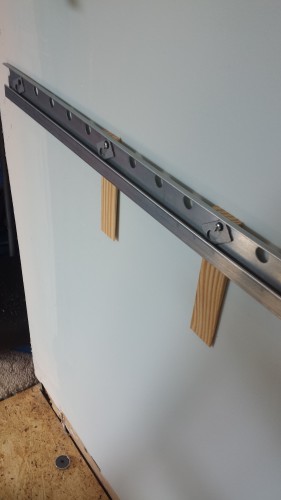
General process I used for installing rail:
- Hold rail so that bottom of the rail is on your line, lining up the holes with as many studs as possible
- Place 4′ level on top of rail and adjust until it is level
- Have a friend use a pencil to mark the holes you want to use
- Put down rail
- Push drywall anchors into wall anywhere you need one (but don’t tighten them yet). Unscrew screws so they’re about 1/2″ out of the wall (but leave anchors flush)
- Place screws in spots where studs are, but leave them 1/2″ or so out of the wall
- Hang rail over screws, observe how ridiculously warped your walls are
The instructions tell you to shim any spots that are significantly recessed. This was a little more of a logistical challenge than I expected due to the drywall anchors. We ended up doing the following for shims over drywall anchors:
- Remove the screw in the spot to be shimmed
- Have one person hold the rail in place while the other places a shim behind where the screw will go
- Mark the center of the hole on the shim
- Mark where the top of the rail hits the shim
- Remove the shim, drill a hole where the screw will go and cut off the excess from the top
- Drill screw about 1/2″ into the shim so that it just pokes out the back
- Remove rail from wall and place the screw/shim combo into the drywall anchors
- Place rail back on wall over screws
- Add weird rectangular washer things that came with the rail
- Tighten everything to the wall, using the 4′ level to make sure everything ends up nice and straight and level
We figured out this strategy through trial and error. One thing that is very different than the old AKURUM line of cabinets is how they mount to the rail. The old ones had a nut like thing that slid into the rail, and then the cabinets lined up with it and were screwed in place. The new ones have a bracket on the back and basically just hang there, with some fasteners to keep them in place. I put one on just to see how it all worked. That cabinet is actually for the island, we haven’t assembled the bottom wall cabinets yet.
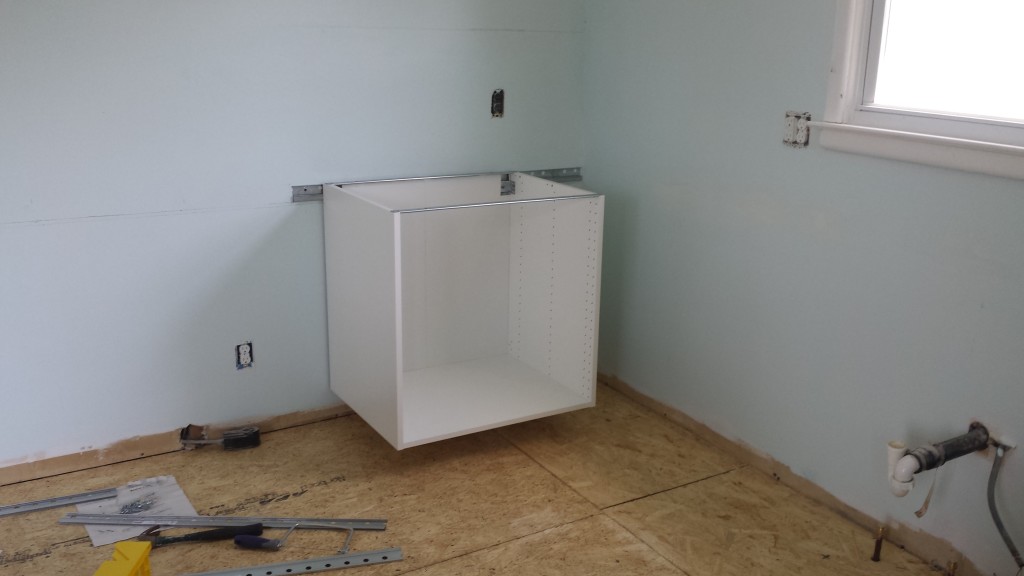
The Ikea instructions tell you to measure / mark out the whole room first, but this doesn’t make sense to me. It’s MUCH MUCH easier to measure for the upper cabinets once you have your lower rails installed and level. I added 1/2″ to my measurements for the upper cabinets because I need a slightly taller backsplash. The backsplash tile we have is 3″ tall, and Ikea’s cabinet spacing is designed for 18.5″ vertically. To avoid having to cut the tile lengthwise I’m adding a little extra space to make room for the grout (which will be 1/8″ spacing between each tile and the counter/cabinets).
We called it a day after getting all the lower rails installed. The upper rails will be a little more annoying, because they’re up high and they’re much longer. We could do it with two people but I think it would be easier with three.
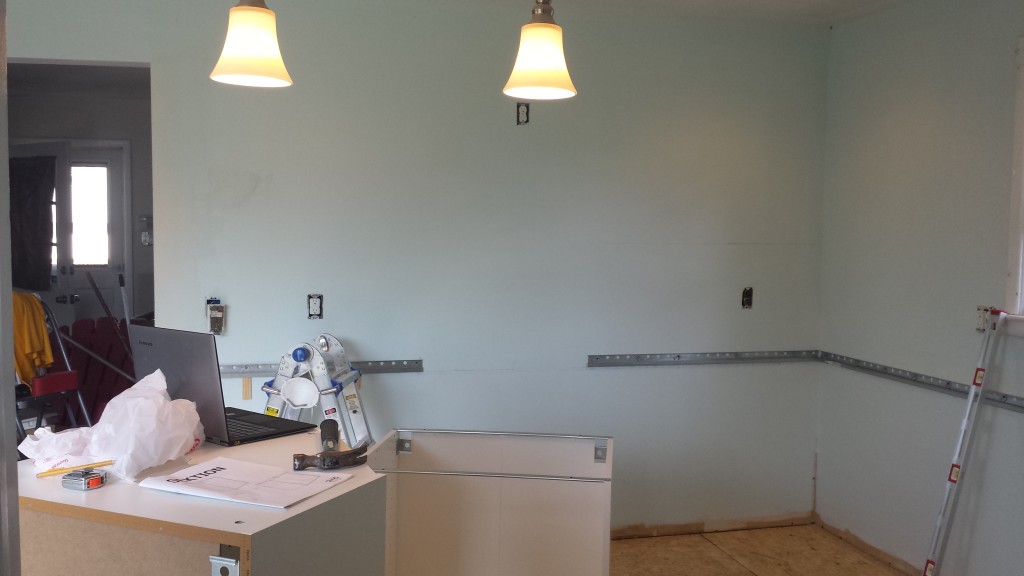
We’re ever so slowly inching towards being able to get the appliances out of the living room!
Want more Ikea cabinet hanging goodness? Check out day 2 of Ikea cabinet installation, or check out the whole DIY Ikea Kitchen Installation process..
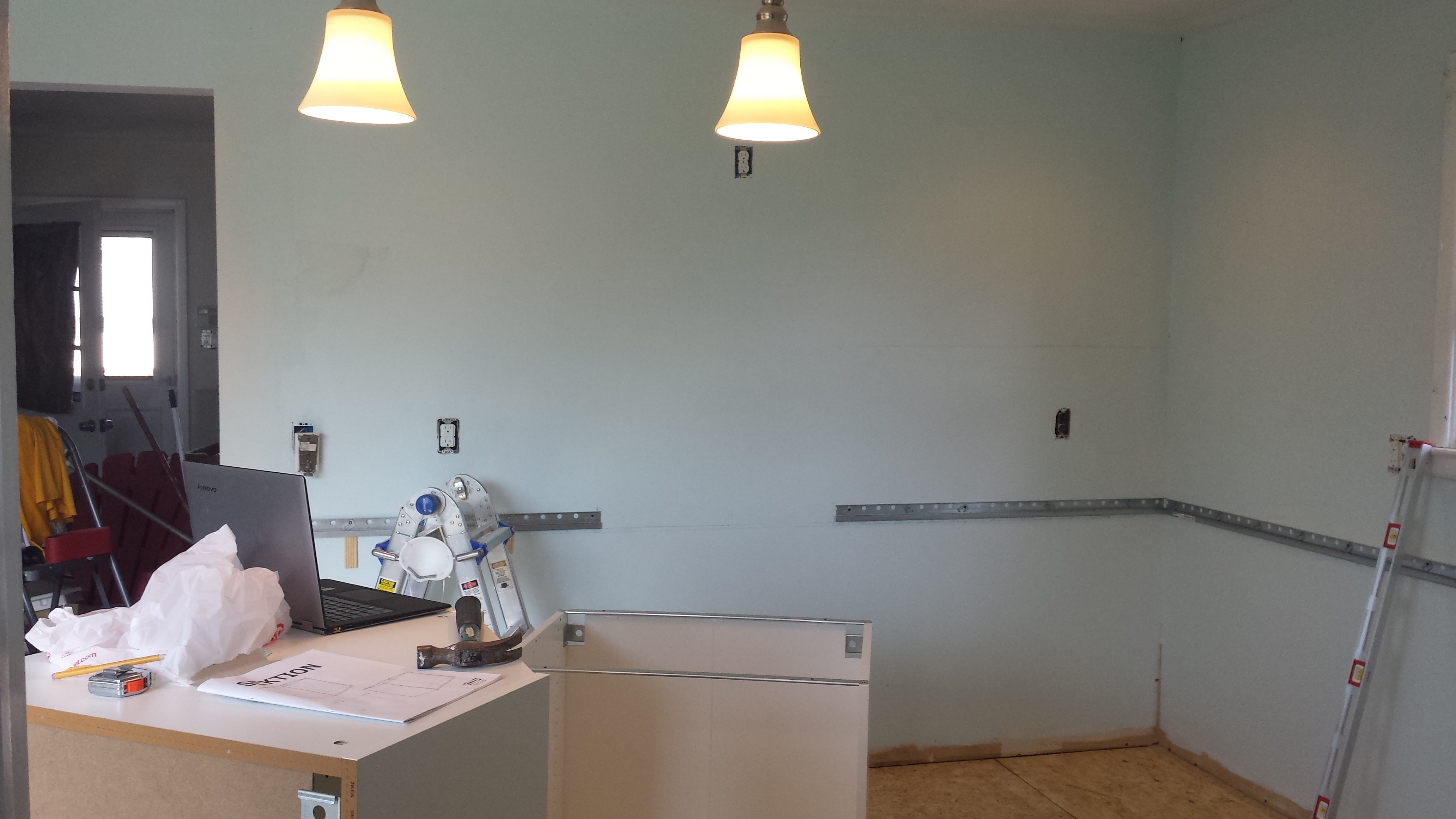
What’s the price difference between installing your own and having someone install them for you?
The rough estimate is $120-140 per cabinet for professional installation. We have 13 cabinets in our roughly 12×12 kitchen. Installing it ourselves is more or less free, the installation hardware and shims came to about $20. The hacksaw I had to buy was $10, and while I’m borrowing my dad’s level for free those run about $20 if you have to buy one new.
What drywall anchors did you use?
For the lower rails I just used some 50 pound hollow wall anchors (aka molly bolts) from the local hardware store. I figured that since the lower cabinets have feet I didn’t need to go quite so crazy. They were something like $6 for a box of 15.
For the upper rails I purchased a box of 100-pound toggle bolts from Lowes, but ended up not needing them because there’s a beam running along the top of the wall. Those cost more like $25 for a box of 20.
Okay, thanks!
Did you need to turn the slotted metal rail washers 45deg, compared to the IKEA instructions which show them horizontal, to keep the bottom of the rail the correct height from the floor?
It wasn’t really a “need” so much as they tend to hang that way and I couldn’t see any reason to spend energy making them horizontal.
What length did you cut your rail? The instructions that come with the rail show exact width of the cabinets. I did a lot of perusing IKEA cabinet installs last night and remember somewhere reading cabinet width minus 1/4″ so you have 1/8″ on either side.
I cut mine to the exact length of the cabinets. You could cut off that 1/4″ if you’re worried, but I have end panels on each cabinet end so you can’t see the rails at all anyway.
Great write up! Do you have a cabinet end piece on any of your lower cabinets? I ask because some install drawings make it look like it should go from the underside of the counter right down to the floor (hiding the cabinet legs), but others show from underside of counter down to the bottom of the cabinet (so you will need a toe-kick on the side to hide the legs).
The end pieces they sold me are only 32.5″ tall, so not tall enough to go right to the floor, but it makes more sense to me that they WOULD go right to the floor.
Which did you do? Thanks!
I have an end piece on one end of the lower cabinets, and it covers just the cabinet. I’ll indeed be putting a toe-kick on that side to hide the legs.
The lower cabinet end panels I was able to use as-is but for the upper cabinets I had to trim them to fit. I actually still have to decide what I’m doing for trim under the upper cabinets (whether I’m gonna use Ikea trim or just get some trim from Home Depot).
Thanks I need to know all this information.
Wow. Kelly, this is badly needed info. I’ve been feeling baffled and worried at the start of our Ikea kitchen instal. And I gotta say that big fat corporate Ikea should be paying bloggers like you for doing their job.
Despite the millions Ikea makes selling kitchen cabinets, I can’t find official youtubes or videos to help us install these no-longer-new Sektion cabinets. Like we can all afford to hire Ikea installers — or even have them available working in our small and distant towns.
So I’ll change companies next time. But thanks so much for helping us make this last big Ikea purchase work.
Thank you for this! We are starting the installation of the cabinets this week. Ikea local assembly and installation price was $140 each cabinet (x17). A so-so contractor price gave a $2,000 estimate and 3 days work (not including the back splash) I mean… seriously??? I have to hands and one working brain. I have a strong smart boyfriend. And we have tons of good information, like this blog, on line. I won’t be paying $2,000!!!! I’m calling a knowledgeable helper tonite, paid by the hour, only to help us find the studs (as my apt is a 1925 it has plaster and wire mesh lath make it impossible to find the studs in any of the traditional ways) and mark where the water pipe is located so we are on the safe side.
The rails, so far, are an amazing headache. I would love to see an IKEA engineer attempt to put up this rail system without swearing once. And IKEA if you’re calling for drywall anchors for this stupid rail system, how about selling them in your super ginormous store? Thanks for giving me a super specific spot to spew!
Thanks for this very useful blog… getting ready to install our cabinets (building ’em this weekend). Glad to have this resource!
One thing I’m not clear on, despite all my research:
Can we attach the Sektion upper wall cabinets so they’re *flush* to the ceiling (assuming ceiling is level/straight)? Or does Sektion’s new “hanging” rail system require that there is some space above the upper cabs (in order to drop the cab onto the rail when hanging)?
If space above upper cabs is required, do you know what the minimum required space above is? We’re looking for a very minimalist look — so no crown molding. We are using the cover panels on the sides though.
Aj
We are installing less then an inch from the ceiling, not so much fun when the original ceiling was not flat we had to take it down and redrywall with shims to make it work.
I assume the suspension rails came with the cabinets as NO WHERE do they say you have to purchase these separately and yours is the first of many blogs etc. that says as much. Aargh and I had scheduled someone to come and help install this weekend.
Mark your studs and location of the upper and lower rails, as in the Ikea Sektion installation guide. Before you cut your rails to length, line up the existing rail holes with your studs and be prepared to cut BOTH ends of your rail to line up the studs to the holes in the length of rail required. Self-levelling laser certainly helps. Take your time to get the rails right and level and also to level base cabinets with the plastic legs attached.
Pro tip: install your upper cabinets first so you don’t have to reach over the lower ones all the time.
I see you don’t monetize your site, don’t waste your traffic, you can earn additional cash every
month because you’ve got high quality content.
If you want to know how to make extra money, search for:
Ercannou’s essential tools best adsense alternative
Thank you so much for all this information. I am so totally confused and ready to quit. Will start fresh tomorrow. I am so glad I’m a dedicated DIYer or I would be totally overwhelmed. Right now on a scale of 1-10 I’m an 8!!!
Thanks for sharing your great tips like this! I really appreciate your article. This is very useful for everyone. I want to share my tips too, just visit my profile.
I don’t know if you are still answering questions here, but I can’t find the answers on Ikea and I like your explanation about finding the right height to put the suspension rail. What I can’t figure out is the purpose of the little plastic legs if the base cabinets are hanging from the rail. Everything else I read says the legs support the cabinets.
purpose of the plastic legs is to attached the toe kick, really not adding structural support for the base cabinets
the height for installing rail can be found on the instructions hanging the rail for the Sektion cabinets
hi there, we have a weird issue. we bought the wrong size cabinet for a place right in the middle of our run but at the end of a countertop. We are wondering if we can get away with installing the countertop and then installing the cabinet later? My thoughts are no because of the rail, etc., but just wanted to see if there was anyway. It might be a couple of months before we can get near an ikea again…
Perhaps someone can tell me for what the four L-shaped plastic pieces with each Glimslov cabinet are used. They are black or nearly black plastic, about 3.5 inch long, and they have four ribs on the outer surface of one flange of the L-shape. The two outer ribs are angled in toward the center of the flange, and the two inner ribs are straight. Looks like these L-shaped pieces are for corners, perhaps to attach something at right angles to something else, but their four ribs are not on the inner angle of the L, but on the outside and on one flange only; and, they are too narrow to slip over the kick guards.
Never assembled base cabinets but it appears the item you described is the holding the back metal frame and back panel of the base cabinet…..see page 11 and 12 of your instructions Dan
It appears that these plastic L-covers are for covering up the inside angoe of the L-brackets used to affix the cabinets to the suspension rail. The Grinslove kitchen cabinets I’m finally installing have no back metal frame. They are the MDF stuff, with two spapping bars front edge and back edge. However, the L-shaped plastic pieces do slide over the inside of the heavy steel angle brackes which are bolted onto the gables of the cabinets and which fasten the cabinets to the suspension rails. The plastic L-shaped pieces seem to cover up the three screws and the fastener, and the extra space in the backing cutout surrounding the angle bracket. So, they are cosmetic at most. Now just two more questions:
1. Does a ready-made plate or fastener exist to join together two shorter suspension rail pieces to make a longer required length? Before I cut and drill one out, or before I buy another suspension raid, I’d like to find a joining plate/piece.
2. Is there a piece to join two shorter toe kick guard pieces to make a longer needed length? (a lot space beneath the kitchen cabinets; the cat could go under perhaps, or another drawer set could be stashed in that space)
I am installing only one 24” wide wall cabinet in my laundry room. There is only one place to hang it and only one stud available. A friend told me it would be fine hanging it with only one stud as long as I use a drywall anchor for 100 pounds in the other spots along the rail. I have a hard time believing only one stud plus 1-2 anchors could hold a 24” x 40” high cabinet filled with detergent and fabric softener. What do you think?
Lisa I would and have cut the drywall and put some blocking in between the studs. Currently hanging some ikea cabinets in the garage and the studs are 24″ on center, no way i would trust drywall anchors so I installed blocking . ran into lots of wire and pipes but was able to work around them
Lisa: does your cabinet have adjustable legs; is it close enough to the ground for that, or is it waist height or higher so that support legs won’t work?
What height did you install the base rails? We followed the instructions and and now our cabinets are resting at 36″ high w/o countertops installed. We are considering lowering the rails down.
Instructions say bottom of mounting rail is supposed to be at 32 3/16 above floor. My assembled cabinet including support feet are 34 1/2″ tall. ( 4 1/2″ feet + 30″ tall base cabinet ). 36″ tall seems high…..are you using the support feet?
So one important measurement that I am curious about that I haven’t been able to find anywhere. What distance from the top of the rail do you drill your holes in the wall in order to guarantee that the top edge will end up exactly where you wanted it to be? In other words, do you drill (center of hole) 1/2″ lower (just a random example) than the top edge?
Thanks
Does the rail bracket come with the skeation rail or do the rail track come with the cabinet. I am trying use the Ikea rail for a non-ikea cabinet.
It comes with the rail